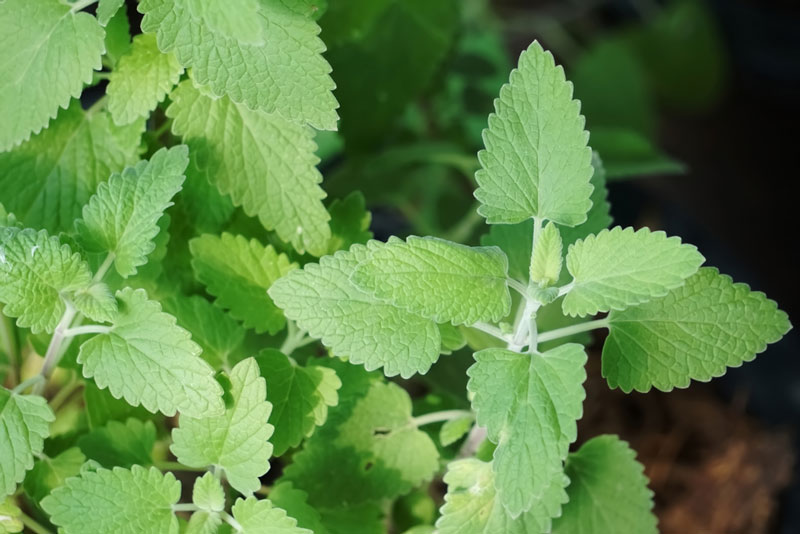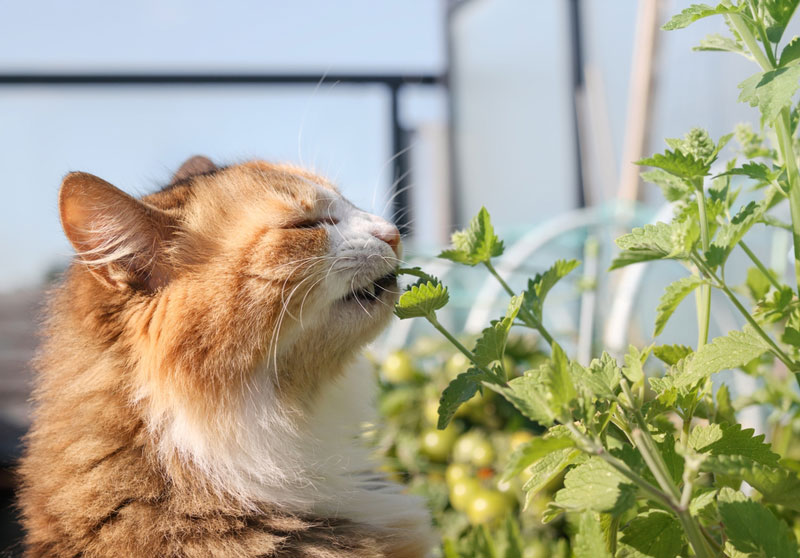Have you ever wondered if cats can eat catnip? The answer is a resounding yes! Cats can safely consume catnip, and it can even be a delightful treat for them. Catnip, a member of the mint family, has compounds that can affect cats positively and provide them with some entertaining moments.
Just like us, cats have their unique tastes and preferences. For many furry friends, catnip is like a magical herb that makes them feel giddy, playful, or even relaxed. It can lead to some pretty hilarious antics—watching them zoom around the room is pure joy!
So, keep reading to find out all the exciting things about catnip, including how much they can eat, the benefits, potential risks, and even some fun substitutes!
You might also be interested in: Can Cats Eat Chia Grass?
Can Cats Eat Catnip?

Catnip comes from the Nepeta cataria plant, which contains a compound called nepetalactone. This magical substance triggers a response in many cats, leading to behaviors like rolling, purring, and playful bounding around the house. You might have seen your cat acting like a tiny tornado after just a whiff of this playful herb! It affects roughly 50 to 75 percent of cats, so if your kitty is in the first group, you can expect some wild entertainment!
But can our feline companions eat catnip safely? Absolutely! Catnip is edible and often used in various forms, such as dried leaves, sprays, and even catnip-infused toys. The best way to offer catnip is to sprinkle a small amount on their favorite toys or bed, or you can reward them with a pinch of dried catnip. Some cats even enjoy fresh catnip straight from the garden. Just remember to keep an eye on their intake to ensure they’re not overindulging. Remember, moderation is key!
How Much Catnip Can Cats Eat?
When it comes to how much catnip our furry friends can enjoy, it varies depending on their individual tastes and sensitivity to the herb. Generally, small amounts are recommended. A pinch of dried catnip is usually enough to get your cat excited. If your pet is a newbie to catnip, starting with a tiny pinch is the best approach. We want your kitty’s experience to be enjoyable, not overwhelming! Some cats may become overactive or distressed if given too much catnip.
Let’s break it down a bit. For adult cats, around one teaspoon of dried catnip a couple of times a week can be a nice treat. Kittens and elderly cats may not respond as vigorously to catnip, so it’s wise to keep their servings smaller. If your cat gets overly hyper, dial back on the amount. Cats generally know their limits, so if they seem uninterested after a few sniffs, it might be their way of telling us they’ve had enough!
After a catnip session, it’s common for cats to have a cooling-off period of about 30 minutes before they can enjoy it again. During this period, they may act a bit dazed, but it’s just the catnip’s effect wearing off. So, if your kitty seems to be taking a catnap, don’t worry. They’ll be up for more fun soon!
It’s also crucial to mention that not every cat responds to catnip the same way. Some cats might seem indifferent while others can act kooky. Genetics plays a role in how they react to catnip, so it’s worth trying it out to see how our feline friends respond. If your kitty seems to love it, you can sneak a sprinkle of catnip on their toys or serve a touch of catnip-infused treats!
Benefits Of Catnip To Cats
1. A Fun Playtime Activity: Catnip can transform our passive couch potatoes into energetic little hunters. The playful behavior that comes out during catnip time can be a great outlet for energy and boredom, encouraging vigorous play. This helps our cats stay active and physically fit.
2. Stress Relief: Many of us might not realize that catnip can offer calming effects for our cats too. If your feline friend tends to be anxious during thunderstorms or fireworks, using a pinch of catnip can provide them with a sense of relaxation and comfort. Watching them enjoy catnip can feel like we’re giving our furry friends a little hug.
3. Social Interaction: Catnip can encourage interactive play between you and your feline buddy. Just toss some catnip on their favorite toy and watch as they pounce and play. This bonding experience can be beneficial for both of you, allowing your cat to appreciate quality time with their human!
4. Enhanced Mental Stimulation: Catnip acts like a natural stimulant for a cat’s brain, causing them to react in playful, energetic, and whimsical ways. This cognitive engagement can act as a stimulating exercise for their minds. It could help moody cats, as it encourages curiosity and stimulation.
5. Encouraging Healthy Eating: If your cat is being a picky eater, you can try mixing a sprinkle of dried catnip into their food. The appealing aroma might entice them to dig in and enjoy their meals. This is especially handy if you are trying to coax elderly cats to maintain their weight and get their nutrients.
Dangers Of Feeding Catnip To Cats
While catnip can bring much joy to our feline companions, it’s essential to acknowledge some risks or side effects involved. One of the most noted responses to catnip consumption is over-stimulation. If our furry friends get too much catnip, they can become overly excited or agitated. Just like us after eating too much candy, they may start to exhibit weird behaviors like excessive meowing, frantic racing, or even slightly aggressive play.
Allergic reactions can occur, albeit rarely. If you notice your kitty sneezing or developing a rash, it might be a sign they aren’t responding well to catnip. In this case, we should stop using it and consult the vet. Again, moderation is key. Too much catnip can lead to gastrointestinal upset, resulting in vomiting or diarrhea.
Although catnip is safe for cats, it’s still important to keep an eye on our cat’s health and reactions. If they seem to be exhibiting unusual or concerning symptoms after eating it, reaching out to a vet is always a wise choice. They’ll be able to help us navigate through any concerns we may have about catnip.
Finally, there is a possibility for dependency. Over time, some cats may develop a strong attachment to catnip, leading them to expect it constantly. This could potentially result in dissatisfaction or disappointment in the absence of catnip. It’s good to rotate catnip time with other engaging activities like interactive toys or play sessions to keep our furry friends happy!
Substitute Of Catnip For Cats
1. Silvervine: If catnip isn’t quite cutting it for your cat, silvervine is an excellent alternative. Silvervine excites even cats that don’t react to catnip. It’s a natural herb that creates a euphoric response in many felines. Simple to find dried, silvervine offers similar benefits as catnip but with a unique twist.
2. Valerian Root: Another substitute is valerian root. This herb may be less common for cat lovers, but many cats respond to it just like catnip. It’s known to encourage excitement and playful behavior in cats. Like catnip, it could make for a great addition to your cat’s toy box.
3. Cat Grass: For a unique substitute, we can explore cat grass. This blend of grasses like wheat, barley, or oat can be a tasty treat that many cats enjoy. It not only aids digestion but also provides a fun munching activity, keeping them busy and entertained.
4. Honeysuckle: Honeysuckle is another fun option! This flowering plant can induce playful behavior in some cats. You can find honeysuckle sticks and toys available at pet stores, or use dried honeysuckle in their toys for added excitement.
5. Interactive Play Toys: Rather than relying solely on herb substitutes, we can also look into interactive cat toys. Whether it’s laser pointers, feather teasers, or automated toys, these can provide different forms of stimulation and exercise for our playful kitties. Variety keeps things exciting for them!
Can Cats Eat Catnip? Frequently Asked Questions
Is Catnip Safe For All Cats?
Yes, for the most part, catnip is safe. However, not all cats respond to it. Always start with small amounts to see how your cat reacts.
Can Kittens Eat Catnip?
Kittens generally show less reaction to catnip, as their sensitivity develops with age. It’s best to wait until they’re around 3 to 6 months old.
How Often Can Cats Have Catnip?
A couple of times a week should be perfect! Avoid giving it daily to prevent overstimulation.
What If My Cat Doesn’t Like Catnip?
Don’t worry! Not all cats are into catnip. Other herbs like silvervine or honeysuckle can provide similar fun experiences.
Can Catnip Help With Anxiety?
Yes, catnip can help many cats feel relaxed and more comfortable during overwhelming situations.
Final Thoughts
Catnip is a safe and delightful treat for our kitty companions. It provides mental stimulation, encourages playful interactions, and can help ease anxiety for many felines. Just remember to moderate their intake, keeping the fun and excitement balanced to avoid any overwhelming responses. By exploring various forms of catnip or considering substitutes, we can ensure our beloved cats enjoy their playtime while keeping healthy.
If you’re interested in learning more about pet care, check out our blog section for helpful articles, including what happens when Can Cats Eat Ferns! Keep exploring and finding ways to make our furry friends’ lives filled with joy and love!
For more helpful articles, check out our blog at Huston Veterinary Blog, where you can find more tips and insights on caring for our beloved pets. Happy pet parenting!


